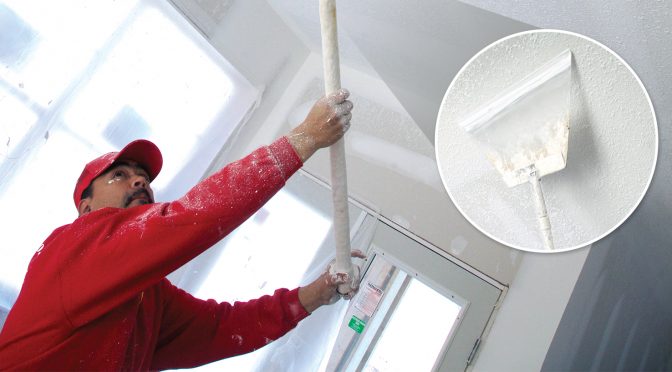Answers to paint pros’ most pressing questions by Rick Watson
I would like to paint a ceiling with texture paint to cover up some imperfections. What’s the best method?
Before doing anything, make sure the surface is clean, dry, dull and sound. First, always clean the surface to make sure any contaminants (grease, oil, dirt, grime) left on the surface will not impede adhesion of the primer or finish.
Then, scrape and sand surfaces* to remove peeling paint. Patch any cracks or holes. Since texture paint will be used, the patching does not have to be perfect. Prime the entire area for uniform color.
If there are water stains or other discoloration, use a stain-blocking primer like Extreme Block Stain Blocking Primer/Sealer. Once the primer is dry, texture paint can be applied.
While many texture paints can be rolled on with a texture roller, the preferred method of application is a texture spray pump. These pumps generally consist of a hopper where the texture paint is poured and attached to a pattern pistol connected to a compressor. When triggered, the texture paint is gravity-fed into a cavity in the gun and blown out onto the surface with air.
This results in a spatter-like effect that can be uniformly applied over the surface. Because of the bumpy appearance and the method of application, this coating is sometimes referred to as popcorn.
There are other non-aggregate texture surfacing products now on the market. One good example is Sherwin-Williams Tuff Surface™ Premium Texture Finish. This can be used for interior walls and ceilings to create a spatter, knockdown or even an orange – peel effect.
The first coat of Tuff Surface is applied by an airless sprayer. Once dry, apply the second coat at packaged consistency, by hopper gun or texture pump and gun to achieve the desired decorative texture.
Varying the orifice size, air pressure and knockdown technique will have an effect on the final appearance. I do suggest testing the desired spray pattern and finish on a sample board first.
Whether rolling or spraying, the application of texture paint can be messy. We recommend removing all furnishings from the room and masking all surfaces – including floors – that are not being coated with texture.
Warning: surface prep
*WARNING! Removal of old paint by sanding, scraping or other means may generate dust or fumes that contain lead. Exposure to lead dust or fumes may cause brain damage or other adverse health effects, especially in children or pregnant women. Controlling exposure to lead or other hazardous substances requires the use of proper protective equipment, such as a properly fitted respirator (NIOSH approved) and proper containment and cleanup. For more information call the National Lead Information Center at 1-800-424-LEAD (in US) or contact your local health authority.
This article was originally published in the Spring 2020 issue of PPC magazine. Rick Watson, director of Product Information and Technical Services at Sherwin-Williams, answers pro questions in the Ask Your ProPartner™ column in PPC magazine.
Got a question for Rick?
Use our secure email contact form

